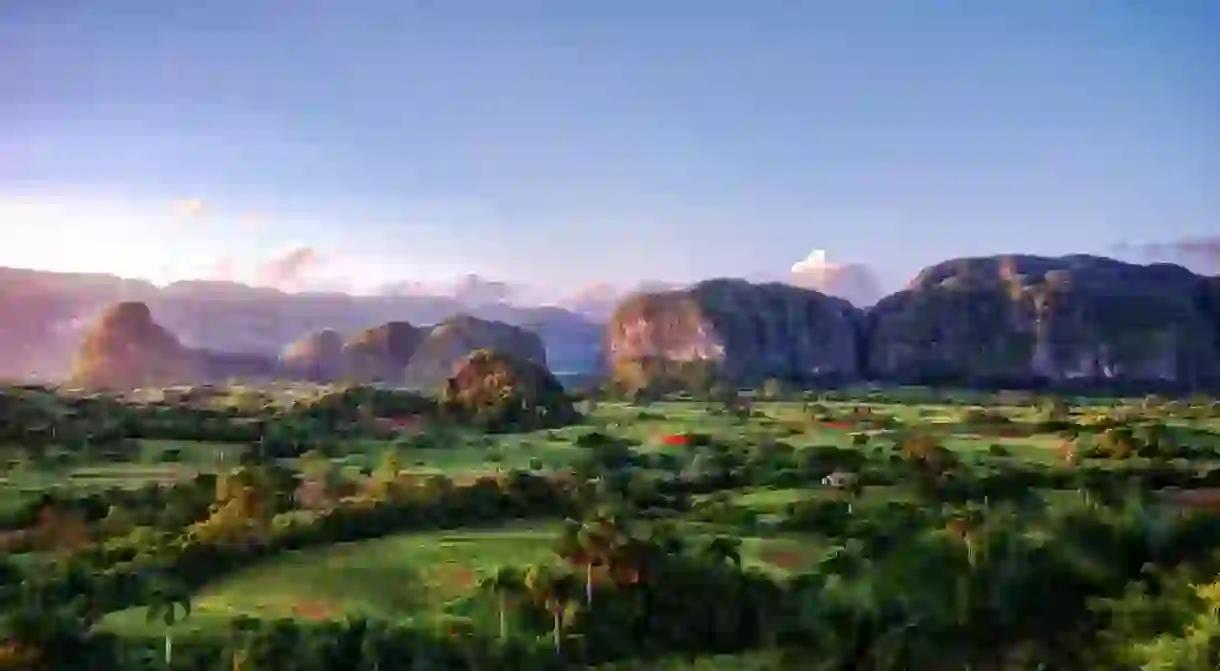The 10 Most Beautiful Spots In Cuba

Cuba is a long, thin island located in the Caribbean and known for its colorful culture, idyllic beaches, and lush forests. Much of the country’s 42,000-plus square miles of land has been recognized by UNESCO World Heritage for its beauty and historic significance. Here we’ve rounded up a list including some of those sites and beyond as the most beautiful spots in Cuba.
Old Havana
Restaurant

Old Havana, or Habana Vieja boasts UNESCO World Heritage status because the city is home to some of the best-preserved history in Cuba. So much so that it feels like time has stopped here. Wander the cobbled streets to find some excellent examples of Baroque and neoclassical architecture like the Cuban Baroque Catedral de San Cristobal as well as historic sites like the Bodeguita del Medio, an old restaurant where Hemingway used to hang out. Don’t miss the Castillo de la Real Fuerza, a military fortress, or the Plaza Vieja, a beautiful town square that serves as an excellent spot to enjoy a mojito in the sun.
Baracoa

Baracoa is a little-known slice of paradise in Cuba. Founded in 1511, it is the oldest city in the country. Unlike touristy resorts, this town has a secluded black-sand beach, peaceful streams, crashing waterfalls to explore and bathe in, and lush forests to hike through. Many visitors come to hike Yunque, a mountain famous for its flat top at 589 meters high that offers incredible views of the sea. Although the hike up is almost entirely vertical, the pathway is shaded and the breathtaking view is so worth the sweat. When you come back into town, you can taste some of the freshest mangoes and papayas in the area.
Trinidad

Trinidad’s collection of a well-preserved history is second only to Havana. The UNESCO site has not changed much since the 1800s, and it has an impressive number of vibrant Spanish-colonial buildings. Visit the nearby Playa Ancon, a beach on the southern coast, and dine on rooftop restaurants to enjoy beautiful views at any time of day. Trinidad’s old town is open only to foot and horse traffic, so visitors are free to roam the street markets and view the iconic bright, pastel houses freely from the narrow, cobbled roads. Around every corner is another picturesque delight in Trinidad.
Playa Paraíso

Playa Paraíso, or Paradise Beach, is an idyllic, Cuban beach that looks like it was cut out of a magazine. Located on the island Cayo Largo del Sur, the strip of beach has soft, white sand, shockingly blue water, and a dry, sunny climate perfect for beach lounging. If you’re looking to do more than lounge and relax, Playa Paraíso is not for you, but if you’re happy to enjoy crystal clear water, clear skies, and plenty of sunshine, it is the best place to go in the country.
Cienfuegos

Cienfuegos is a city with a clear European style full of grandiose architecture. Called the Paris of Cuba, this city has French influences in both its customs and style. Stroll around the harbor-side town to find the beautiful bay Bahia de Jagua and the art galleries around the Plaza de Armas. Throughout the city and on the coastal drive west to the Bay of Pigs are elaborate, colorful mansions.
Valle de Viñales
Natural Feature

Explore this sprawling valley nestled in the Sierra de Los Órganos mountain range. The UNESCO site is filled with tiny towns, towering, rounded limestone cliffs, stick straight pine trees, and traditional tobacco farms. Bike, hike, or ride horses through the lush valley and enjoy the slow way of life. The biggest cigar brands in the country are supplied with tobacco grown in the Valle de Viñales, the area that epitomizes rural Cuban life.
Alejandro de Humboldt National Park
Park

Alejandro de Humboldt National Park is one of the most biologically diverse tropical island sites on the earth. The UNESCO World Heritage Site houses an incredible number of varied plant and animal life because of the adaptations the species have made to survive the toxicity of the park’s underlying geography. Located on the northern coast of eastern Cuba, the forested mountain area offers guided tours and hikes along dirt roads and pathways filled with colorful birds, majestic waterfalls, and abundant greenery.
Peninsula de Zapata

Bird watchers and nature lovers should visit this remote area of Cuba for some of the most breathtaking natural sites on the island. Filled with the Parque Nacional Ciénaga de Zapata, the peninsula is one of the largest wetland areas in the Caribbean. The park is a UNESCO Biosphere Reserve and home to around 150 species of birds, including rare bandicoots, waterhens, parrots, and much more. Crocodiles roam the swampland throughout the peninsula, but animal lovers can safely see them up close at the Criadero de Cocodrilos crocodile farm.
Caya Coco
Bridge

Caya Coco is a stunning rural beach famous for appearing in two of Hemingway’s novels, Islands in the Stream and The Old Man and the Sea. The beach is connected to mainland Cuba by a bridge, but you can also travel by air to the Jardines del Rey archipelago island. The white-sand beaches are covered by cloudless skies and plenty of sunshine, and the gently lapping water is a beautiful turquoise color. Visit the Parque Natural el Bagá to see crocodiles, turtles, and flamingoes.
The Malecón

This famous waterfront promenade is one of Havana’s most popular areas and an essential stop for anyone traveling through Cuba. The idea was conceived in 1901, and the Malecón was partly built in 1902. The 7-kilometer road offers a place to walk along the sea and view a well-preserved mixture of different 20th-century building styles in beautiful pastels. There is always something to do on the Malecón. From people watching and lounging by seawall during the day to mixing with the musicians and dancers at night.
By Courtney Stanley
By Courtney Stanley













